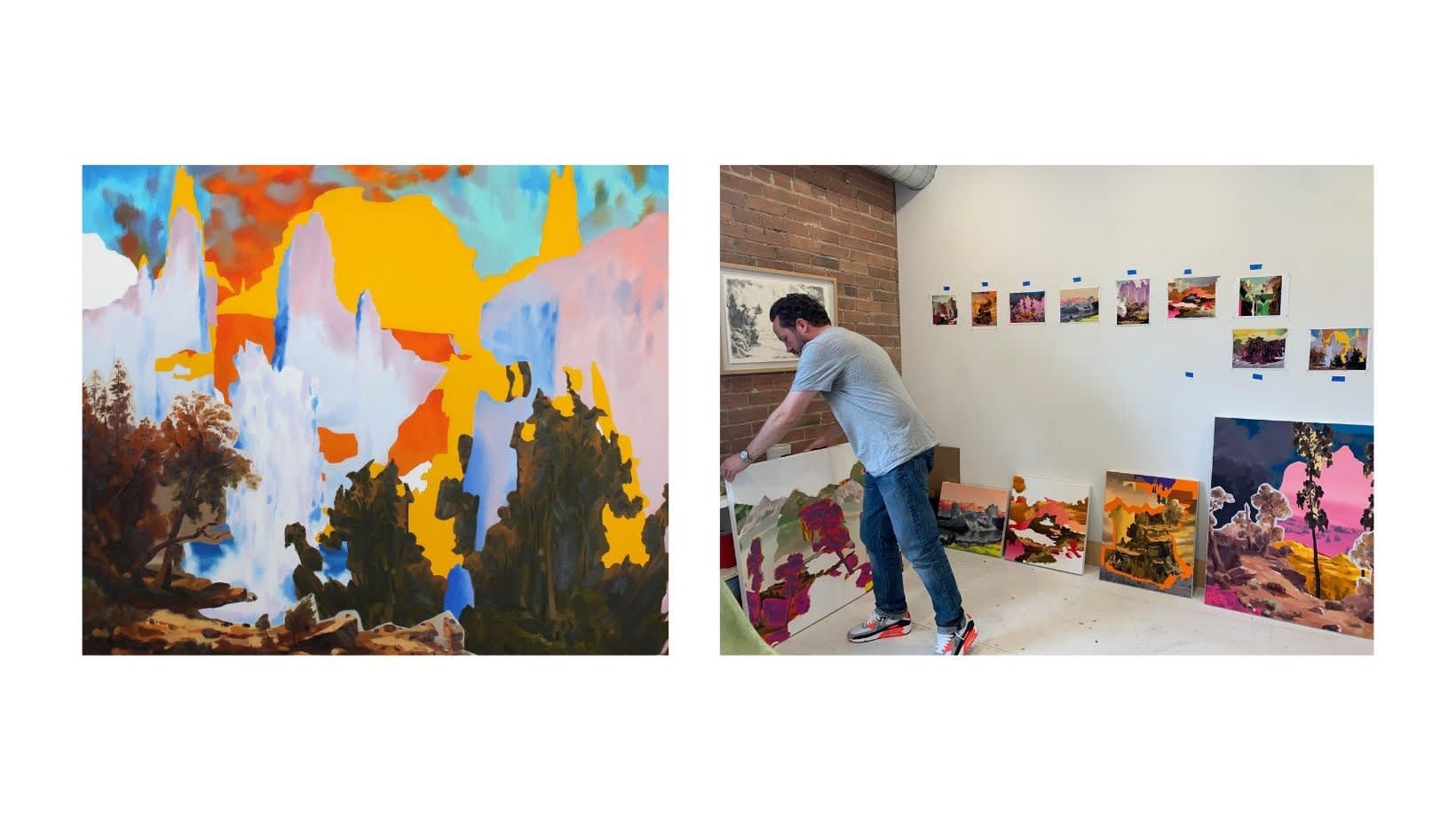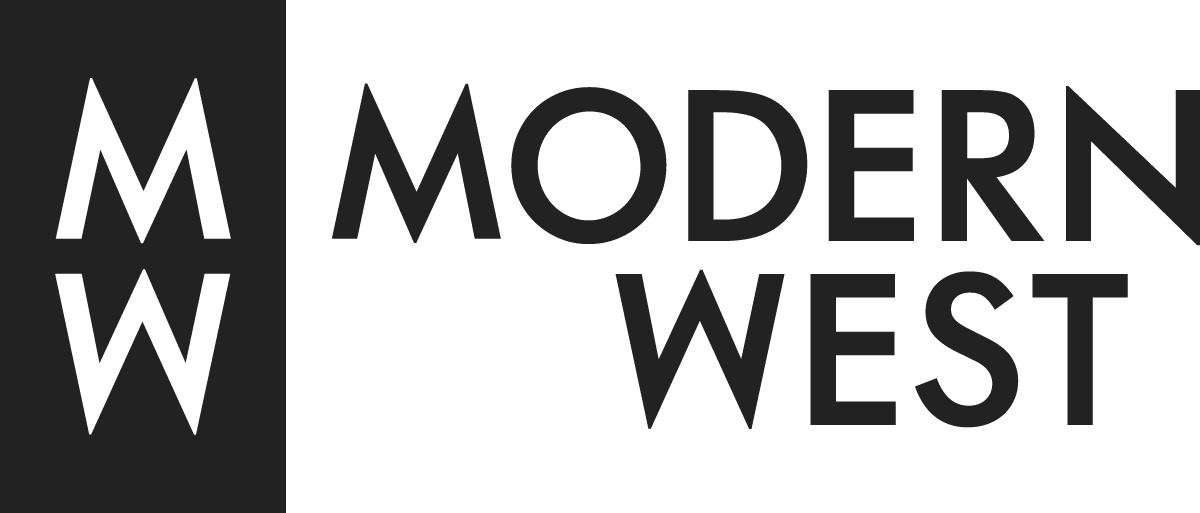
You earned your MFA from California State University, Long Beach in 2006 and your BFA from Brigham Young University in 2003. How do you think living, studying, and working in the American West has influenced the themes in your work that your artist statement touches on (“Critical perspectives of American exceptionalism, Manifest Destiny, and American Identity ”)?
I grew up in Utah, then lived in California for most of my adult life, and now I'm back in Utah. While they are very different places from a political and cultural standpoint, they both have incredible landscapes that are central to their identities as states and central to the development of the identity of our country.
In the 19th century, artists depicted the landscapes of the West as an untouched, unexplored wilderness that was America’s for the taking. The conquest of this landscape reinforced ideas about American exceptionalism, rugged individualism, and the belief that nature was not only God’s creation but also something to be conquered and exploited as a resource.
Fast forwarding to 2021, you don’t have to look too far to see how these beliefs have shaped ideas about America and framed the current discussion surrounding politics, religion, social interactions, and the environment.
Your last body of work examined, “ . . . visual experience in the internet era, the anxiety of responding to a torrent of information, and the complexities of living in an attention-based economy.“ How have you transitioned from a body of work that focused on attention-based economy to this most recent body of work focused on American Exceptionalism and Manifest Destiny?
The attention-based economy was a primary concern of my last body of work called “Miscellaneous Debris”. In that series, I gave myself license to explore any topic or subject that was of interest to me. It quickly became an exercise in futility about trying to keep up with everything that the internet throws at you everyday.
During the pandemic, when I had less time to paint and more time to think, I worked to figure out what subjects I was gravitating towards and why. I wrote all of the subjects I was engaging on the wall in my studio and tried to figure out what they had in common. Eventually I boiled it down to a Venn diagram of 3 circles: spectacle, absurdity, and desire. Where these themes overlap is where I find subjects to be most compelling.
My transition to a focus on American Mythology occurred during the pandemic and the 2020 election cycle. It felt important but also impossible to address current events because of the speed at which things were happening and changing. However, a few questions kept coming to mind: What does it mean to be an American in our current day? What are our expectations for our country? And, where do these expectations come from?
I wanted to address the foundations and framework of America’s identity which are completely wrapped up in spectacle, absurdity, and desire. 19th Century Romantic landscape painting seemed like a perfect place to start because it truly contains all three in equal parts and was a critical component of shaping the American ethos.
There are small collage works you have compiled on the wall in your studio. Are the collages a plan or support for your painting practice, or are they their own entities with meaning that stand apart from the paintings?
In this body of work I’m using collage as a compositional tool because I want to mimic the process of creating composite landscapes that was used in the 1800s. One of the artists I’m looking at very closely is Albert Bierstadt. His process involved taking trips to the American West to make studies and take photos of the landscape. Then he would return to his studio in New York and make grandiose, composite landscape paintings which were used to motivate people to go and ‘settle’ the West. Despite playing into the sentiments of the time, Bierstadt developed a reputation for over exaggerating to the point of creating landscapes that were unidentifiable, completely fictitious, and, in some cases, an ‘affront to God and His creation’.
Collage is interesting to me because of the way it mimics the process of creating super landscapes from multiple sources, similar to Bierstadt. More importantly, I value collage because of all the ways I can deconstruct, manipulate, and reassemble an image. This act of deconstruction is a metaphor for the way that American mythologies are being called into question, examined, and reconstructed today.
To answer your question, although I do see the collages as an important step in my process, they are ultimately used as references for the paintings. The paintings are the final product because I see them as the completion of the process of reassembling and tying everything back together in a singular, cohesive image.
Your recent landscape paintings are gorgeous, large-scale, and the colors are so bright. How do they explore these themes of American Exceptionalism, Manifest Destiny, Romanticism, etc.?
Thank you! Color is a very important tool in my practice because of how powerful and seductive it can be. Earlier I mentioned spectacle, desire, and absurdity as they relate to American exceptionalism, Manifest Destiny, and Romanticism. The color is very much about all of those themes. When you introduce colors that are overly intense or manipulated, they play into the spectacle of the painting and also set up an interesting quandary for the viewers: They clearly know that the color is not natural and therefore undermines the integrity of the landscape and the painting. But it is also very attractive. So do they approach the painting from a critical standpoint and focus on the absurd nature of the painting or do they allow themselves to be swept up by the romantic nature of the color? Or, can they allow themselves to do both?
I see this as a parallel to one of the most fascinating questions about being an American today: How do each of us choose to reconcile the emotional and intellectual responses we have to our history and the current moment?
Your artist statement and body of work feel very philosophical—reminiscent of Jean Baudrillard’s philosophy “The Evil Demon of Images”— do you have a favorite philosopher, or philosophy? There are also a few books on painters of the American West like Albert Bierstadt in your studio, what are you reading and listening to while you’re Upstairs?
The idea of applying ‘The Evil Demon of Images’ to Romantic landscape painting in the 1800s is very interesting. I like the concept of the image (or painting) contaminating reality and ultimately creating an implosion of reality and image. Those paintings had an enormous impact on the perception of the American West and in turn shaped the reality of it.
I wouldn’t say that I have a favorite philosopher, but right now I’m trying to understand the psychology and values of the 1800s that led to the popularity of an artist like Bierstadt. One of the books I’m reading right now is ‘Nature’ by Ralph Waldo Emerson. Emerson set the conceptual and philosophical framework for the arts in America during that time and I know that many of the painters of the era read and bought into it. Coincidently, Tyler Green just released a book entitled ‘Emerson’s Nature and the Artists’ which I am looking forward to reading.
What are your next steps? In what direction do you see your work moving during and after this residency?
I always try to introduce new variables and challenges with each series of paintings I make. This body of work is brand new territory for me so during the residency I am really focused on how to construct the composition using multiple sources and then translate it into a painting. One thing I’m specifically experimenting with right now is allowing the residuals from working in Photoshop to stay in the collages and the paintings. For example, you’re going to see empty spaces, flat shapes, intense color, and areas that clearly demonstrate my lack of skill in photoshop.
There are times when I wonder what would happen if I tried to make the paintings more seamless and natural like a Bierstadt painting that purports to be a singular image of a singular place. Maybe I could try being more subtle about the manipulations I make in the landscape and take a more cerebral approach. But then again, I’m not sure. That intense color always gets me.
ARTIST BIO
Jerrin Wagstaff is an artist based in Salt Lake City, UT. He earned his Master of Fine Arts from California State University, Long Beach in 2006 and his Bachelor of Fine Arts from Brigham Young University in 2003. Since graduating, his work has been featured in several solo and group shows throughout the country: at Another Year in LA, Los Angeles, CA, Nox Contemporary in Salt Lake City, UT, Torrance Art Museum, the Center for Contemporary Art in Sacramento, CA, the Utah Museum of Contemporary Art, the San Diego Art Institute, and CUAC Contemporary Art in Salt Lake City, UT. In addition to his professional art practice, for over a decade Wagstaff has taught at various colleges and universities, is a contributor for The Contemporary Art Digest, and was a resident at the Guthrie Artist Studios in downtown Salt Lake City, UT.


